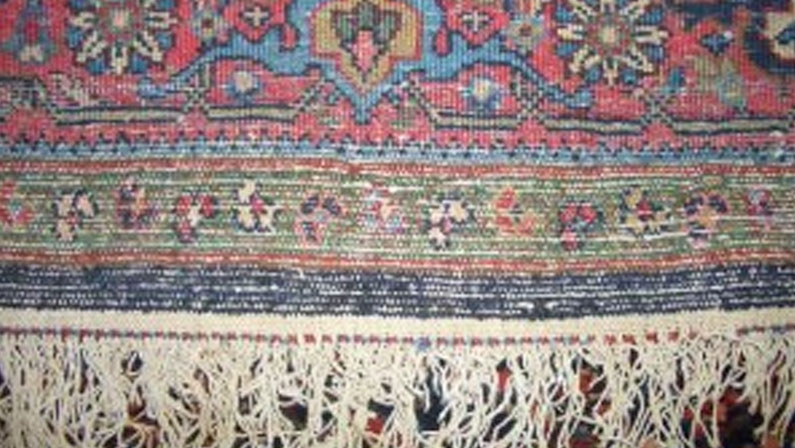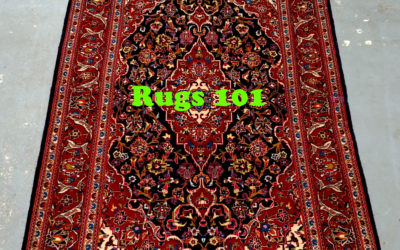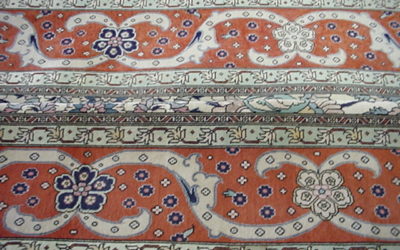
I Think Knot
A rug recently came into our shop for repair, and it was something that even my dad had never seen before. It was a rug that was started using one type of knot technique and then completed using another.
On the surface of the rug you can’t tell a thing. It looks totally normal. However, when you hold the rug, you can easily feel that one side of the rug has a lot less heft than the other.

Because learning types of weaves is one of the harder things that I’m still trying understand, I thought I’d write up this rug as a little case study from which we can all learn. In the following picture, you can see that the weave of the rug changes a little bit, right about where the light blue of the bigger, inner border ends. See?

The end of this rug is done in a Turkish knot which is often used in the region of Hamadan and other tribal areas. Above the outer border of the rug, a Persian knot is used. This is more prevalent in the area of Arak or Sarouk which is geographically very close to Hamadan. (Assumption Alert: Turkish knots are not called Turkish because they were invented in Turkey. The knots have been around a lot longer than Turkey the country, and while it is possible that the technique was invented long ago in what is today the country of Turkey, no one really knows for sure.)
Here is a close-up of the Persian knotted section of the rug:

Let’s look at a close-up of the the Turkish knots now:

Now, if you have a sec, go ahead and google Turkish and Persian Knots. You’ll be able to see close up drawings of the structure of these knots. I know, it doesn’t help much, but maybe after staring at the above pics for a while, it will click later.
I’ll point out what I’m noticing and what I’m hoping I will recognize in rugs down the road. The Persian knots from the back appear to be perfect little boxes. The Turkish knots look like two, side-by-side boxes. If I didn’t know better, I would count each half of the Turkish knot as a separate knot, but now I know that the Turkish knot is a little bit wider and consists of two boxes, bumps, lumps, loops, thingies, or whatever you want to call it, and in the Persian, only one of these per knot is visible. As a rule of thumb, finer rugs are done with a Persian knot, and less fine rugs are done with a Turkish knot. Or, translated into Katie speak, formal living room rugs are done in a Persian knot, and family room rugs are done in a Turkish knot.
Now, back to this particular rug with an identity crisis. I have no explanation for what happened here. Perhaps the first weaver was fired or won the lottery and left the weaving business entirely? It isn’t very often that one weaver does both types of weaves. This rug remains a mystery, but perhaps it has helped us to unravel the issue of the Turkish vs. Persian knot.
Other Posts We Think You’d Enjoy:
Rugs 101: Parts of a Rug (Part II)
Thanks for coming back! This is the second part of a two part series about the various parts of a rug. In this post, you'll learn all of the basic rug terms which refer to the structural parts of a rug. You can see the first part which addresses the decorative parts...
Rugs 101: Parts of a Rug (Part I)
Hello, Friends! Enjoy this post I created about the various parts of a rug! It has been quite some time since I posted on this blog of ours, and now that we have a brand new website, it only seemed fitting to take up writing again. As we rebuilt our website, I...
My Experience with Window Tinting and Rug Fading
When my husband and I did the final walk-through of our current home, the previous owner told us that they had had the living room and dining room windows tinted because the wood floors were being bleached by the sun and that their long term plan, had they not decided...


